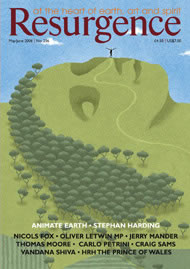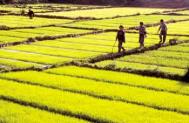THIS IS THE FIRST time we have had the pleasure of publishing an article by Craig Sams. He is a champion of whole food and organic farming. He is famous for his Green & Black’s chocolate and is Chair of the Soil Association.
Craig’s ancestors were farmers, as were mine. According to Indian tradition there are three ways to cultivate the land. The first is the satvik way: farming as a spiritual practice, using methods which are gentle, simple and subtle. The food produced in this way is nourishing, revitalising and refreshing. When the act of working the land in itself is satisfying and fulfilling, then you know that you are practising satvik farming.
The second is the rajsik way: power-farming, controlling land and people. The word raj indicates rule and power as in the British Raj. Rajsik farming is practised by feudal landlords. Though unjust and unequal, landlords may still possess a love of the land, a passion for conservation, and a willingness to allow forests, streams and wildlife to be.
The third is the tamsik way. Tamas means sinister; dark, depressing and devitalising. Farming which is destructive of land, livelihood and natural diversity. Farming which uses pesticides and herbicides leading to terminator technologies and genetic manipulation. When the act of farming makes you feel guilty, ashamed and unhappy then you know that you have fallen into the tamsik trap.
Craig Sams’ description of modern American farming shows how agriculture which should be a satvik activity has turned into a tamsik trade. Farmers are forced to use land and crops as commodities. They are cajoled into putting increasing amounts of chemicals onto the land to get bigger and bigger crops, without respecting the soil and the natural life which is sustained by it. Because of the industrialisation of agriculture, the practice of monoculture and increasing globalisation, farmers are unable to make a decent living. They have to depend on government subsidies. Farming at the present time is in a poor and depressed state, and farmers are committing suicide in many countries.
Because of the tamsik mindset, large industrialised farms are producing food that is also tamsik. Factory farms, intensive livestock rearing, cruel slaughterhouses and feeding farm animals an unnatural diet including growth hormones and antibiotics are surely a tamsik practice. Use of fossil fuels to transport animals and meat and other kinds of frozen food causes global warming, which makes the entire enterprise a tamsik business.
The champions of agribusiness believe that the satvik form of farming is a sign of underdevelopment. If you live in rural areas, if you live by sun, wind and water, if you are close to the land and the seasons, if you husband the soil and the crops then you are in need of World Bank loans! You had better sell your small farm and join the rat race of the commercial and financial world with their high-tech solutions.
In their minds gentle, small farms are uneconomic, impractical, backward, nostalgic and unworkable. But in reality organic and human-scale farming methods are the most sustainable, the most compassionate and the most pleasurable. Millions of farmers in India, Africa and South America are still practising such satvik, such gentle farming.
The tamsik way of farming is failing miserably, as Craig Sams argues, and we need to move from tamsik to satvik farming and embrace artisan food, slow food and satvik food.
SATISH KUMAR








